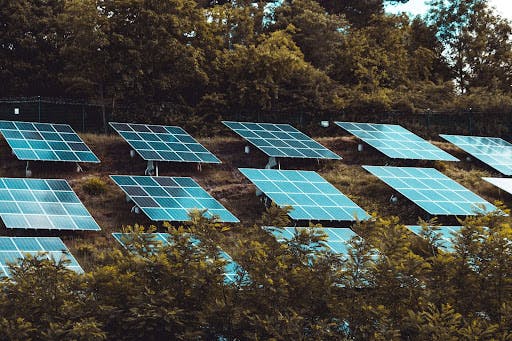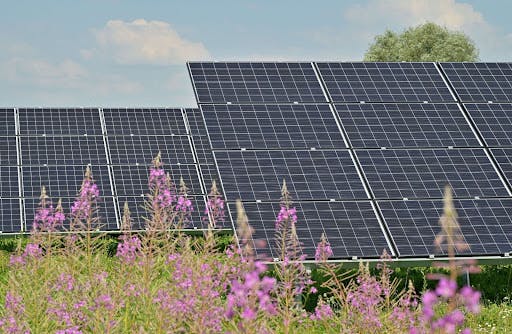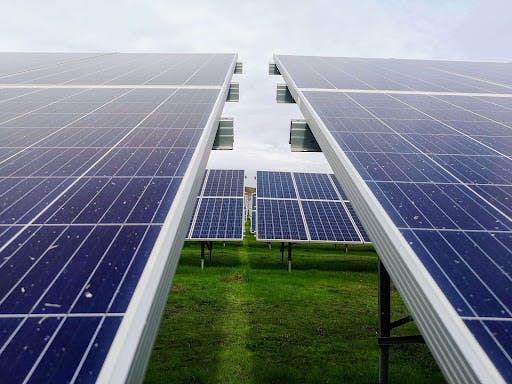Monocrystalline vs Polycrystalline Solar Panels: What’s The Difference?
19 Jun 2023

Solar farm developers have many important decisions to make when starting their renewable energy projects, and one of these is which type of solar panel to use.
In this article, we’ll hone in on the difference between monocrystalline and polycrystalline solar panels, to help solar farm developers to make an informed choice.
What are the pros and cons of each? How are both types of panels manufactured? What is their environmental impact? Here we address these questions and set out other important characteristics of monocrystalline and polycrystalline solar panels.
Understanding Monocrystalline and Polycrystalline Solar Panels
So, you have sign-off, all the permits are sorted, and as part of the solar project development process, it is now time to choose your solar panels.
Monocrystalline and polycrystalline panels are two of the main types used on solar farms. Both are similar in that they are made from silicon but are manufactured differently.
Monocrystalline solar cells – also known as wafers – are the more premium of the two. Production begins with the creation of a single silicon crystal formed into a large ingot cylinder or bar, which is then sliced into thin wafers with a diamond saw. Each cell is a single slice of this crystal. The manufacturing process for monocrystalline panels costs more and produces more waste due to the shaving of the square silicon wafers to make a distinctive cell shape.
In contrast with the single crystal of monocrystalline cells, the solar cells in polycrystalline solar panels consist of silicon fragments that have been melted together. This is why polycrystalline solar cells are also called multi-crystalline cells. It is an easier production process with a higher margin of error and hence is the cheaper of the two. However, performance is impacted by the imperfections.
Efficiency & Performance
Monocrystalline solar panels have a higher energy conversion efficiency compared to polycrystalline panels. This is primarily because monocrystalline panels are cut from a single crystal of silicon, allowing for a more efficient flow of electricity through the panel.
In real terms, monocrystalline panels produce more energy per square foot, meaning they require less space to generate the same amount of energy compared to polycrystalline panels.
When it comes to temperature and low-light conditions, both types of solar panels are affected. However, monocrystalline solar cells tend to perform better in hot weather and low-light situations. Their superior efficiency in collecting solar energy makes them more resilient under challenging environmental conditions.
In terms of lifespan, monocrystalline panels have a slower degradation rate due to their high-grade silicon composition. Both monocrystalline and polycrystalline panels typically have a lifespan of 25-30 years, with many manufacturers offering a 25-year warranty for their products.
Overall, monocrystalline solar panels offer higher efficiency, better performance in varying conditions, and a longer lifespan compared to polycrystalline panels. These factors make monocrystalline panels a popular choice for those seeking optimal energy production and long-term reliability.

Aesthetics & Design
Visually, there is a clear difference between monocrystalline and polycrystalline silicon solar panels.
Monocrystalline panels look different to polycrystalline panels because of their silicon structure. The silicon structure interacts with the sunlight to determine how the panels are seen by the human eye. The single-crystal structure of monocrystalline cells produces a black colour, in contrast to the light blue of polycrystalline cells.
Some solar farm developers prefer the black sheen produced by the single-crystal, high-grade silicon surface of monocrystalline panels. This is a more consistent look than the speckled blue appearance of polycrystalline panels, which require treatment for even colouring.
Cost & Return on Investment (ROI)
One crucial aspect to consider when comparing polycrystalline and monocrystalline panels boils down to finances.
Monocrystalline panels come with a higher upfront cost compared to polycrystalline panels. The reason behind their higher price tag lies in their superior silicon structure, as well as the more complex and expensive manufacturing process involved. In the UK, the approximate cost of monocrystalline panels is around £1-£1.50 per watt, while polycrystalline panels range from £0.90-£1 per watt.
Despite the initial investment being higher for monocrystalline panels, their superior efficiency and slower degradation rate result in a greater return on investment (ROI) for solar farm developers in the long run. Taking into account the improved performance and longer lifespan, monocrystalline panels prove to be a more financially advantageous choice over time.
Environmental Impact and Sustainability
Both monocrystalline and polycrystalline solar panels are made from silicon, which is a brittle and conductive material that enables the generation of electricity from solar radiation through photovoltaic cells.
During the manufacturing process, silicon is obtained from silica through mining and then refined. The refined silicon is crystallised into ingots and subsequently cut into strips known as wafers.
Although both types of panels are silicon-based, the production of monocrystalline solar panels has a slightly higher environmental impact compared to polycrystalline panels. This is primarily due to material waste resulting from the shaving of square silicon wafers.
However, it's important to note that monocrystalline panels may have higher overall sustainability due to their longer lifespan and superior efficiency, which contribute to reduced environmental impact over time.
When it comes to recycling and disposal, various components of solar panels can be recycled. Glass, which typically constitutes around 75% of a solar panel's weight, is widely recyclable. Additionally, materials such as silicon, aluminium, copper, and plastic used in the composition of solar panels can also be easily recycled.
The recycling process involves removing the frame, cables, and junction box from the panels before they are cut and ground down. Through mechanical sifting and separation, metals can be extracted, and glass and silicon can be separated.
Considering that a significant number of solar panel systems have been installed in the last decade, the majority of existing systems are expected to remain operational for many years to come. This indicates that the need for recycling and disposal of solar panels will likely increase in the future.

PF Nexus
PF Nexus is helping to break down barriers across the landscape of renewable energy project investment by offering a comprehensive solution that enhances global connectivity and visibility. This platform serves as a centralised hub, enabling development and investment teams to easily identify, research, and explore various renewable energy project opportunities.
Subscribers to PF Nexus gain access to a robust ecosystem database and a project marketplace. Within this platform, they can thoroughly evaluate investment deals and collaborate seamlessly with transaction advisors and project owners in the renewable energy sector. The platform caters to a wide range of renewable projects, including utility-scale solar, wind, battery storage, and other sustainable infrastructure, ensuring a diversified investment portfolio.
With an ever-growing community of over 4,600 users, consisting of clean energy investors, lenders, advisors, and developers from more than 2,600 organisations, PF Nexus is rapidly gaining momentum in the industry. If you’re looking to secure solar power project funding, raise investment, or sell your solar project, then get in touch today
Conclusion
Solar farm developers must weigh the advantages and considerations of monocrystalline and polycrystalline solar panels.
Monocrystalline panels offer slightly higher efficiency, slower degradation rates, and a more visually appealing design. However, they do come with a higher upfront cost.
On the other hand, polycrystalline panels are more cost-effective initially and have improved their efficiency over time. To make the best decision, developers should carefully assess their project requirements, budget, and long-term goals.
Understanding the distinctions between monocrystalline and polycrystalline solar panels allows developers to make informed choices that align with their specific needs when starting a solar farm. As the importance of renewable energy grows, selecting the right solar panel technology contributes to the success and sustainability of solar farm projects.